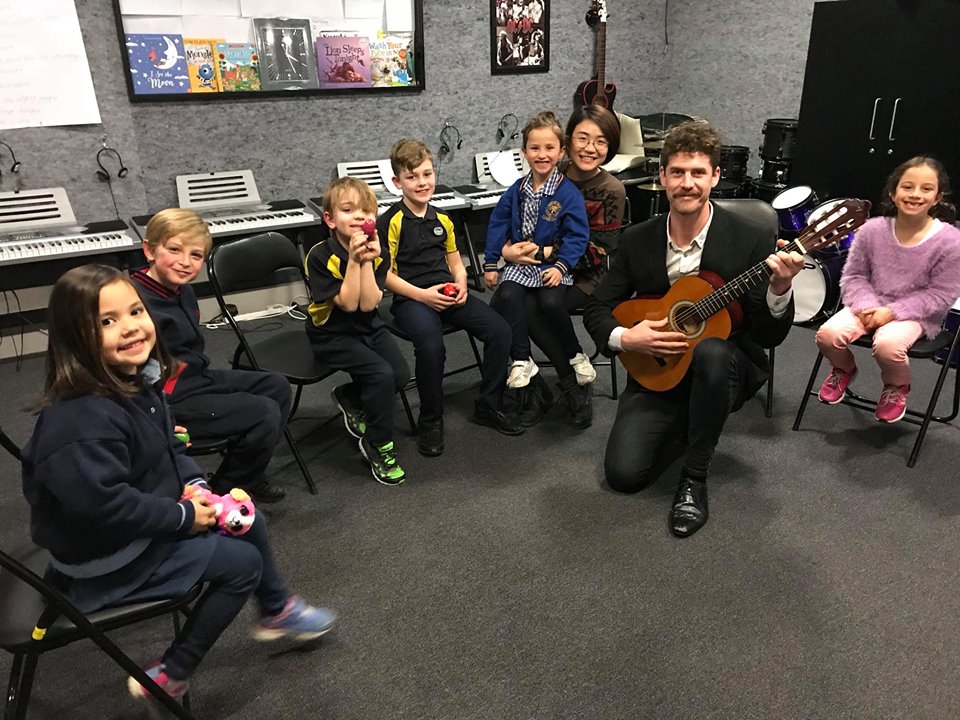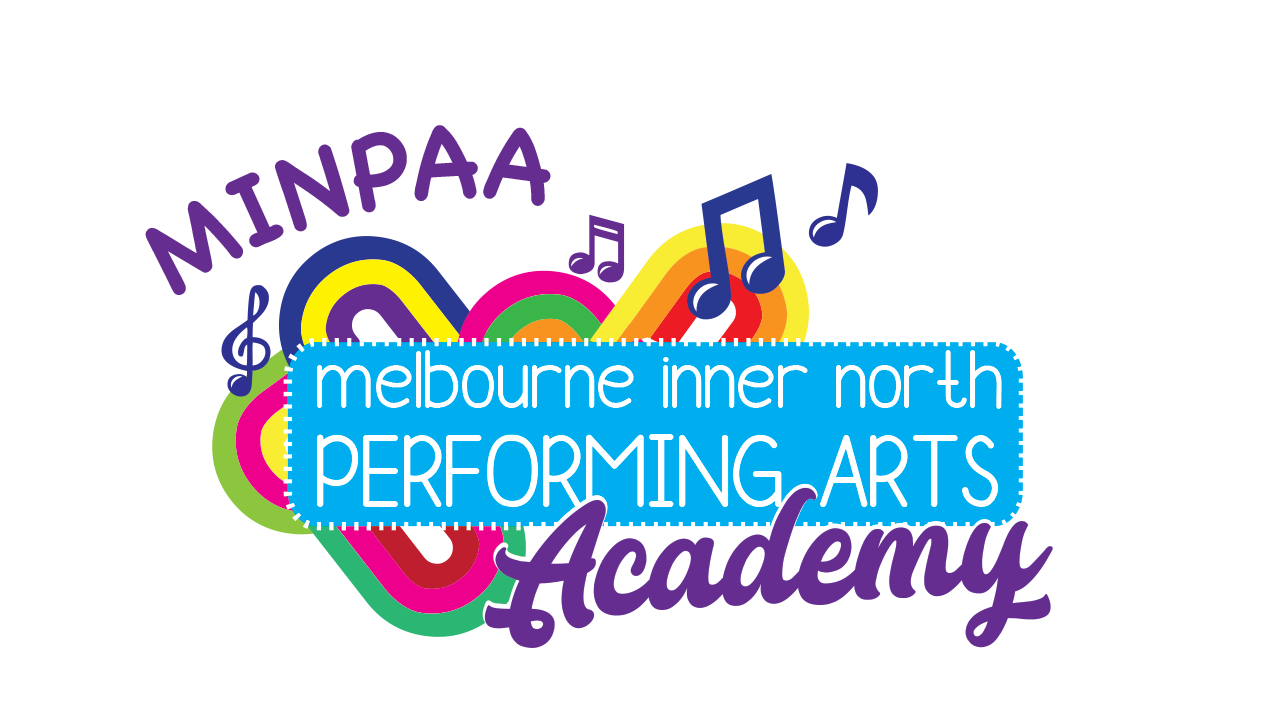Learning in Music
At the Melbourne Inner North Performing Arts Academy, we adhere to the Victorian Music standards of education at all times
In all music classes, students listen to, compose and perform music in a wide range of styles from diverse cultures, times and locations. and listening underpins all music learning.
Students compose and perform music using the voice, body, instruments, found sound sources, and digital technologies. As composers, they create music in different styles and forms exploring personal interests and given ideas.
Students develop their ability to identify and describe, using terminology and symbols (notation), aspects of the music they listen to, compose and perform.
Learning through Music is a continuous and sequential process, enabling the acquisition, development and revisiting of skills and knowledge with increasing depth and complexity
In Music, students’ exploration and understanding of the elements of music, compositional devices, musical conventions, styles and forms expands with their continued active engagement with music.
Students listen to and perform music from a range of cultures, times and locations. In each band, students learn about increasingly complex forms of music as they make and respond to different musical styles and genres from a range of contexts. These may include different types of songs and instrumental genres, music in film and media, contemporary and new music trends, and folk and art music from varied cultures, times and. locations, traditions and styles.
Music learning begins with music experienced in students’ lives and community and draws on the histories, traditions and conventions of music from other places and times including Australia, Aboriginal and Torres Strait Islander cultures, Asia and other world cultures.
Students identify the purposes of music across cultures, times and locations.
As they engage with music from a broad range of styles, practices, traditions and contexts, students learn to recognise their preferences and consider diverse perspectives of music. This, in turn, informs the way in which they interpret music as performers and how they respond to the music they listen to. These experiences also inform students’ development of a unique musical voice as composers and their own style as performers.
Making in Music involves active listening, improvising, composing, arranging, conducting, singing, playing, interpreting, practising, recording and notating, comparing and contrasting, rehearsing, refining, presenting and performing.
Responding in Music involves students being audience members, listening to, enjoying, reflecting, analysing exploring, appreciating and evaluating.
Making and Responding are intrinsically connected. Together they provide students with knowledge, understanding and skills as artists and audience. As students make they consider both the audience and their own response to their work and as students respond they draw on the knowledge, understanding and skills acquired through their experiences in making artworks and as audiences of other artists’ work.
In Music, both making and responding involve developing an aural understanding of the elements of music through experiences in listening, composing and performing. The elements of music work together and underpin all musical activity.
Students learn to make music using the voice, body, instruments, found sound sources and technologies. Music is recorded and communicated as notation using symbols and terminology and as audio recordings.
Music practices
When making and responding, students develop musical skills through activities that draw on the practices of listening, composing and performing, separately and in combination.
These learning experiences are supported by additional activities including learning and creating notation to record and communicate musical ideas; reading, writing and interpreting a range of terminology, notation and scores; making audio recordings of compositions and performances using technology; and developing skills and techniques to discuss their own music and the music of others.
The elements of music
Music is learned through developing skills and knowledge associated with the elements of music. Musical ideas are conceived, organised and shaped by aspects and combinations of rhythm, pitch, dynamics and expression, form and structure, timbre and texture.
Viewpoints
As they make and respond in Music, students learn that responses are informed by different viewpoints and that these shift according to different world encounters. As students make, investigate or critique music as composers, performers and audiences, they may ask and answer questions to interrogate, explore and investigate the composers’ and performers’ intentions, and the audiences’ interpretations.
Understandings and interpretations are informed by contexts and an understanding of how elements, materials, skills and processes are used.
These questions provide the basis for making informed critical judgments about their own music and the music they interpret as musicians and listen to as audiences. In the later years, students will consider the interests and concerns of composers, performers and audiences regarding philosophies and ideologies, critical theories, institutions and psychology.
Materials
The initial materials of music are the voice and body, instruments and other sound sources. Additional materials include recorded music and scores, technologies such as recording and playback equipment and software, and spaces for creating, practising and performing.
At the Melbourne Inner North Performing Arts Academy, we adhere to the Victorian Music standards of education at all times
In all music classes, students listen to, compose and perform music in a wide range of styles from diverse cultures, times and locations. and listening underpins all music learning.
Students compose and perform music using the voice, body, instruments, found sound sources, and digital technologies. As composers, they create music in different styles and forms exploring personal interests and given ideas.
Students develop their ability to identify and describe, using terminology and symbols (notation), aspects of the music they listen to, compose and perform.
Learning through Music is a continuous and sequential process, enabling the acquisition, development and revisiting of skills and knowledge with increasing depth and complexity
In Music, students’ exploration and understanding of the elements of music, compositional devices, musical conventions, styles and forms expands with their continued active engagement with music.
Students listen to and perform music from a range of cultures, times and locations. In each band, students learn about increasingly complex forms of music as they make and respond to different musical styles and genres from a range of contexts. These may include different types of songs and instrumental genres, music in film and media, contemporary and new music trends, and folk and art music from varied cultures, times and. locations, traditions and styles.
Music learning begins with music experienced in students’ lives and community and draws on the histories, traditions and conventions of music from other places and times including Australia, Aboriginal and Torres Strait Islander cultures, Asia and other world cultures.
Students identify the purposes of music across cultures, times and locations.
As they engage with music from a broad range of styles, practices, traditions and contexts, students learn to recognise their preferences and consider diverse perspectives of music. This, in turn, informs the way in which they interpret music as performers and how they respond to the music they listen to. These experiences also inform students’ development of a unique musical voice as composers and their own style as performers.
Making in Music involves active listening, improvising, composing, arranging, conducting, singing, playing, interpreting, practising, recording and notating, comparing and contrasting, rehearsing, refining, presenting and performing.
Responding in Music involves students being audience members, listening to, enjoying, reflecting, analysing exploring, appreciating and evaluating.
Making and Responding are intrinsically connected. Together they provide students with knowledge, understanding and skills as artists and audience. As students make they consider both the audience and their own response to their work and as students respond they draw on the knowledge, understanding and skills acquired through their experiences in making artworks and as audiences of other artists’ work.
In Music, both making and responding involve developing an aural understanding of the elements of music through experiences in listening, composing and performing. The elements of music work together and underpin all musical activity.
Students learn to make music using the voice, body, instruments, found sound sources and technologies. Music is recorded and communicated as notation using symbols and terminology and as audio recordings.
Music practices
When making and responding, students develop musical skills through activities that draw on the practices of listening, composing and performing, separately and in combination.
- Listening is the process through which students experience and learn music. This includes listening to, analysing and comparing a range of repertoire. Students develop listening skills and techniques for discriminating, identifying, interpreting and applying musical concepts.
- Composing is a broad term for creating original music. In education settings this involves improvising, organising musical ideas, creating accompaniment patterns, and arranging and writing original works, either individually or collaboratively.
- Performing involves playing instruments, singing or manipulating sound using technology, either as an individual or ensemble member. This includes learning and interpreting songs, instrumental pieces, accompaniments, and works composed by self and others. Audiences can include the teacher, peers, the wider school community and public audiences.
These learning experiences are supported by additional activities including learning and creating notation to record and communicate musical ideas; reading, writing and interpreting a range of terminology, notation and scores; making audio recordings of compositions and performances using technology; and developing skills and techniques to discuss their own music and the music of others.
The elements of music
Music is learned through developing skills and knowledge associated with the elements of music. Musical ideas are conceived, organised and shaped by aspects and combinations of rhythm, pitch, dynamics and expression, form and structure, timbre and texture.
Viewpoints
As they make and respond in Music, students learn that responses are informed by different viewpoints and that these shift according to different world encounters. As students make, investigate or critique music as composers, performers and audiences, they may ask and answer questions to interrogate, explore and investigate the composers’ and performers’ intentions, and the audiences’ interpretations.
Understandings and interpretations are informed by contexts and an understanding of how elements, materials, skills and processes are used.
These questions provide the basis for making informed critical judgments about their own music and the music they interpret as musicians and listen to as audiences. In the later years, students will consider the interests and concerns of composers, performers and audiences regarding philosophies and ideologies, critical theories, institutions and psychology.
Materials
The initial materials of music are the voice and body, instruments and other sound sources. Additional materials include recorded music and scores, technologies such as recording and playback equipment and software, and spaces for creating, practising and performing.

